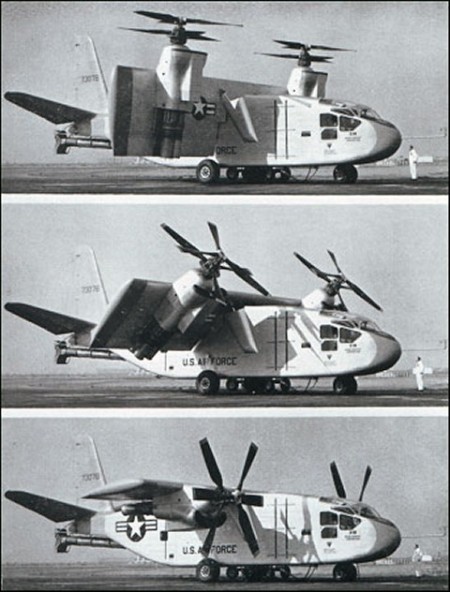Fifty-three years ago this week, the USAF/Hiller X-18 Tilt-Wing research aircraft made its flight test debut at Edwards Air Force Base, California. Hiller test pilots George Bright and Bruce Jones were at the controls of the experimental VSTOL vehicle.
A VSTOL aircraft is one which is capable of Vertical and/or Short Take-Off and Landing. This ability to fly in the vertical provides a VSTOL aircraft with the tactical advantage of operating from small clearnings and short runways. While vertical flight is integral to it operation, a VSTOL aircraft flies the majority of its mission in horizontal flight just like conventional aircraft.
In the middle 1950’s, the rapidly-maturing state of aviation technology allowed aircraft designers to seriously consider the possibility of a VSTOL aircraft for the first time. A key technical hurdle was the transition from vertical to horizontal flight and back. To do so safely and effectively, particular attention had to be focused on aircraft flight control and propulsion.
The Hiller X-18 VSTOL aircraft employed a unique tiltable wing that permitted it to fly both in the vertical and in the horizontal. Power was provided by twin Allison YT40-A-14 turboprop engines with a maximum rating of 5,850 hp. Each powerplant drove a counter-rotating propeller having a diameter of 193-in. The overall propulsion system was capable of producing 45,000 lbs of lift.
The X-18 employed a third powerplant for aircraft pitch control. In particular, a Westinghouse J34-WE-36 turbojet with a maximum thrust of 3,400 lbs was used for this purpose. Pitch control was effected by diverting the engine’s exhaust stream through a long, ventrally-mounted tailpipe, at the end of which was located a vertically-firing nozzle.
The X-18 aircraft measured 63 feet in length and featured a unique tiltable wing having a span of 48 feet. The wing tilt mechanism could rotate the thrustline of the twin turboprops from horizontal to vertical. Gross take-off and empty weights were 33,000 lbs and 27,272 lbs, respectively. The X-18 had a top speed of 253 mph and a maximum altitude of 35,300 feet.
The one and only X-18 VSTOL aircraft (S/N 57-3078) made its first flight test on Tuesday, 24 November 1959 at Edwards Air Force Base, California. With Hiller test pilots George Bright and Bruce Jones as the air crew, the X-18 flew for 18 minutes. Maximum altitude and speed were 4,000 ft AGL and 170 knots. The test flight was entirely nominal in all respects.
The X-18 flight test program ended just a year after it began. While the aircraft was found to be quite stable and easy to control, flight safety of the type was particularly sensitive to hardware failures. An event that occurred during the twentieth (20th) and final flight of the experimental vehicle illustrates this point.
On Friday, 04 November 1960, the X-18 suddenly departed controlled flight while flying at 11,000 feet over Edwards Air Force Base. Test pilots George Bright and Bruce Jones struggled to regain flight control as their ship flipped into an inverted spin. Displaying uncommon airmanship, the Hiller air crew regained control at 6,000 feet and managed to safely land their stricken steed. The initiating problem was later traced to a motor governor assembly which had all of its gear teeth stripped off.
Though it flew only briefly, the X-18 made notable contributions to early VSTOL technology. It was the first large-scale VSTOL aircraft flown in the United States and the first to employ the tilt-wing concept. Unfortunately, the X-18 airframe no longer exists. It met an ignominious end when it was dismantled and its parts sent to scrap sometime following termination of the type’s flight test program.

